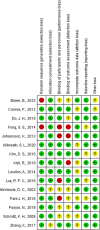The effects of ACSM-based exercise on breast cancer-related lymphoedema: a systematic review and meta-analysis
- PMID: 39108540
- PMCID: PMC11300927
- DOI: 10.3389/fphys.2024.1413764
The effects of ACSM-based exercise on breast cancer-related lymphoedema: a systematic review and meta-analysis
Abstract
Background: Breast cancer-related lymphedema (BCRL) frequently occurs after axillary lymph node dissection and remains incurable even with lymphaticovenular anastomosis. Exercise interventions have emerged as a potential non-pharmacological management approach. However, standardized exercise recommendations tailored to BCRL patients are lacking.
Purpose: This study evaluated the impact of high and low compliance exercise interventions, aligned with ACSM recommendations, on quality of life (QOL), shoulder range of motion (ROM), and arm volume in BCRL patients. It further aimed to determine the optimal exercise dosage, assessed via the FITT (frequency, intensity, time, type) principle, that maximizes health benefits for BCRL patients.
Methods: Adhering to the PRISMA guidelines for systematic reviews and meta-analyses, we conducted a comprehensive literature search in various databases, including PubMed, Embase, Cochrane Library, and Web of Science, encompassing the period from the inception of these databases to December 2023. We extracted data on exercise form, frequency, intensity, duration, repetitions, and sets from the identified studies. Subsequently, a meta-analysis and review were conducted. The exercise interventions were evaluated based on ACSM recommendations and categorized as either high or low compliance with ACSM standards. Fixed or random effects models were employed to compare outcomes across study subgroups with comparable results. Additionally, funnel plot analyses, sensitivity analyses, and Egger's and Begg's tests were conducted to evaluate the potential for bias.
Results: 15 studies encompassing 863 patients with BCRL were analyzed. Eleven studies exhibited high ACSM compliance, while four demonstrated low ACSM compliance. Regarding QOL, the overall standard mean difference (SMD) was 0.13 (95% CI: -1.07, 1.33). Specifically, the SMD for the high-adherence subgroup was 0.91 (95% CI: 0.33, 1.49; p = 0.002). For ROM, the overall SMD was 1.21 (95% CI: -0.19, 2.61). For arm volume, the overall SMD was -0.06 (95% CI: -0.22, 0.10). QOL results differed significantly in the high-adherence subgroup, whereas no significant effect on ROM or arm volume was observed.
Conclusion: The study revealed significant QOL improvements in patients with high ACSM compliance, contrasted with those with low compliance. Conversely, no notable changes in ROM or arm volume were observed. Notably, the high adherence group tended to show better ROM during exercise and stable arm volume. Future research is needed to validate these findings.
Keywords: ACSM; breast cancer-related lymphedema; exercise; meta-analysis; systematic review.
Copyright © 2024 Luan, Li, Yang, Xu, Chen, Wang, Chen and Ge.
Conflict of interest statement
The authors declare that the research was conducted in the absence of any commercial or financial relationships that could be construed as a potential conflict of interest.
Figures








Similar articles
-
The effects of exercise based on adherence to ACSM recommendations on pulmonary function and quality of life in adults with asthma: a systematic review and meta-analysis.Front Physiol. 2025 May 15;16:1548382. doi: 10.3389/fphys.2025.1548382. eCollection 2025. Front Physiol. 2025. PMID: 40443451 Free PMC article.
-
Effects of exercise based on ACSM recommendations on bone mineral density in individuals with osteoporosis: a systematic review and meta-analyses of randomized controlled trials.Front Physiol. 2023 Jul 17;14:1181327. doi: 10.3389/fphys.2023.1181327. eCollection 2023. Front Physiol. 2023. PMID: 37528896 Free PMC article.
-
A recommended exercise program appropriate for patients with knee osteoarthritis: A systematic review and meta-analysis.Front Physiol. 2022 Oct 3;13:934511. doi: 10.3389/fphys.2022.934511. eCollection 2022. Front Physiol. 2022. PMID: 36262252 Free PMC article.
-
Effects of exercise dose based on the ACSM recommendations on patients with post-stroke cognitive impairment: a systematic review and meta-analyses.Front Physiol. 2024 Jun 3;15:1364632. doi: 10.3389/fphys.2024.1364632. eCollection 2024. Front Physiol. 2024. PMID: 38887320 Free PMC article.
-
The impact of aerobic exercise dose based on ACSM recommendations on patients with Parkinson's disease: a systematic review and meta-analysis of randomized controlled trials.Front Aging Neurosci. 2024 Oct 3;16:1419643. doi: 10.3389/fnagi.2024.1419643. eCollection 2024. Front Aging Neurosci. 2024. PMID: 39430975 Free PMC article.
Cited by
-
The Effects of Concurrent Training on Molecular, Functional, and Clinical Outcomes in Breast Cancer Survivors: A Pilot Study.Cancers (Basel). 2025 Jun 13;17(12):1967. doi: 10.3390/cancers17121967. Cancers (Basel). 2025. PMID: 40563617 Free PMC article.
References
-
- American college of sports medicine position stand (1998). American college of sports medicine position stand. The recommended quantity and quality of exercise for developing and maintaining cardiorespiratory and muscular fitness, and flexibility in healthy adults. Med. Sci. sports Exerc. 30 (6), 975–991. 10.1097/00005768-199806000-00032 - DOI - PubMed
-
- Bittar S., Simman R., Lurie F. (2020). Lymphedema: a practical approach and clinical update. Wounds 32 (3), 86–92. - PubMed
Publication types
LinkOut - more resources
Full Text Sources
Other Literature Sources

